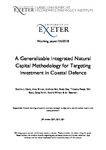A generalisable integrated natural capital methodology for targeting investment in coastal defence
| dc.contributor.author | Davis, KJ | |
| dc.contributor.author | Binner, A | |
| dc.contributor.author | Bell, A | |
| dc.contributor.author | Day, B | |
| dc.contributor.author | Poate, Tim | |
| dc.contributor.author | Rees, Sian | |
| dc.contributor.author | Smith, G | |
| dc.contributor.author | Wilson, K | |
| dc.contributor.author | Bateman, I | |
| dc.date.accessioned | 2019-09-19T12:37:48Z | |
| dc.date.available | 2019-09-19T12:37:48Z | |
| dc.date.issued | 2018-10-31 | |
| dc.identifier.issn | 2160-6544 | |
| dc.identifier.issn | 2160-6552 | |
| dc.identifier.uri | http://hdl.handle.net/10026.1/14925 | |
| dc.description.abstract |
Coastal ecosystems, such as saltmarsh, produce a range of ecosystem services that underpin human well-being. In the UK, and globally, saltmarsh extent and quality is declining due to coastal squeeze, deteriorating water quality, and agricultural activities. Here, we develop a general framework to evaluate changes in coastal defence. Using this framework, we identify priority areas for saltmarsh re-alignment: re-creation of saltmarsh in areas that have been saltmarsh in the past–but that have been claimed for a variety of land uses, particularly agriculture. We base our re-alignment prioritisation on the ecosystem services provided by saltmarsh in the North Devon Biosphere Reserve: specifically carbon sequestration and recreational benefits, and the economic values of those services. We compare potential economic benefits with the economic costs of creating new saltmarsh areas–specifically lost agricultural output, property damages and direct re-alignment costs. We identify a number of priority areas for managed re-alignment that generate high recreational values in areas where properties would not be damaged. These findings provide a necessary and timely analysis for the managers of the North Devon Biosphere Reserve. Furthermore, we outline a comprehensive methodology to plan future management of coastal zones. | |
| dc.format.extent | 429-446 | |
| dc.language | en | |
| dc.language.iso | en | |
| dc.publisher | Taylor & Francis (Routledge) | |
| dc.title | A generalisable integrated natural capital methodology for targeting investment in coastal defence | |
| dc.type | journal-article | |
| dc.type | Journal Article | |
| plymouth.issue | 4 | |
| plymouth.volume | 8 | |
| plymouth.publication-status | Published | |
| plymouth.journal | Journal of Environmental Economics and Policy | |
| dc.identifier.doi | 10.1080/21606544.2018.1537197 | |
| plymouth.organisational-group | /Plymouth | |
| plymouth.organisational-group | /Plymouth/Faculty of Science and Engineering | |
| plymouth.organisational-group | /Plymouth/Faculty of Science and Engineering/School of Biological and Marine Sciences | |
| plymouth.organisational-group | /Plymouth/REF 2021 Researchers by UoA | |
| plymouth.organisational-group | /Plymouth/REF 2021 Researchers by UoA/UoA07 Earth Systems and Environmental Sciences | |
| plymouth.organisational-group | /Plymouth/REF 2021 Researchers by UoA/UoA14 Geography and Environmental Studies | |
| plymouth.organisational-group | /Plymouth/Users by role | |
| plymouth.organisational-group | /Plymouth/Users by role/Academics | |
| dcterms.dateAccepted | 2018-10-07 | |
| dc.rights.embargodate | 2019-12-18 | |
| dc.identifier.eissn | 2160-6552 | |
| dc.rights.embargoperiod | Not known | |
| rioxxterms.funder | Natural Environment Research Council | |
| rioxxterms.identifier.project | South West Partnership for Environment and Economic Prosperity (SWEEP) | |
| rioxxterms.versionofrecord | 10.1080/21606544.2018.1537197 | |
| rioxxterms.licenseref.uri | http://www.rioxx.net/licenses/all-rights-reserved | |
| rioxxterms.licenseref.startdate | 2018-10-31 | |
| rioxxterms.type | Journal Article/Review | |
| plymouth.funder | South West Partnership for Environment and Economic Prosperity (SWEEP)::Natural Environment Research Council | |
| plymouth.funder | South West Partnership for Environment and Economic Prosperity (SWEEP)::Natural Environment Research Council |


